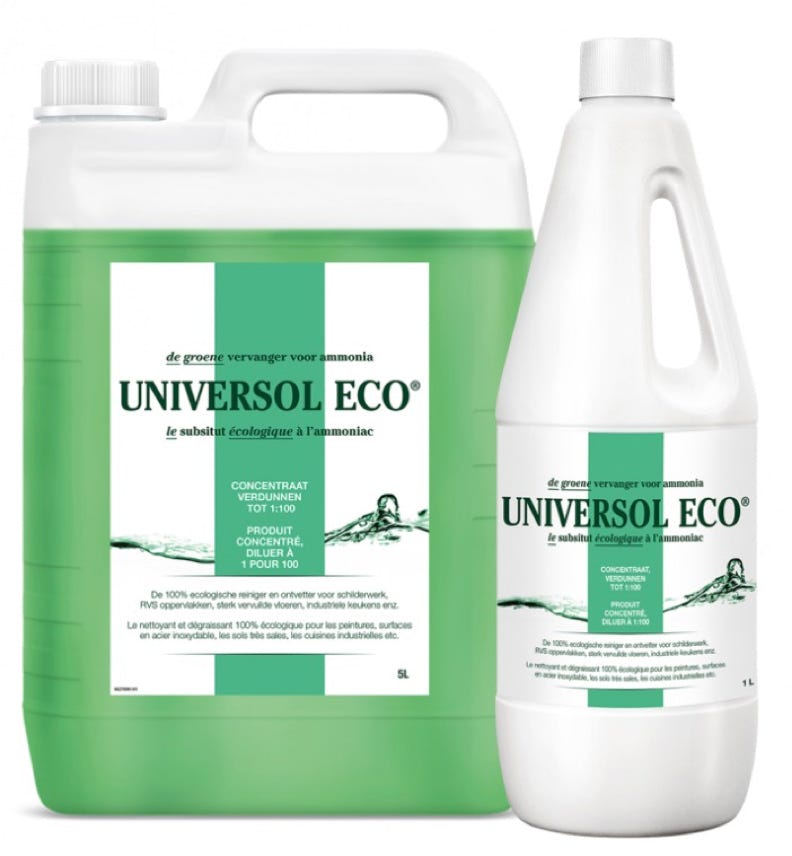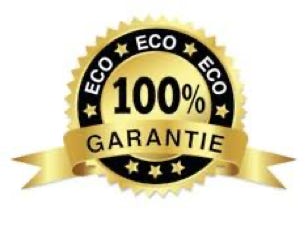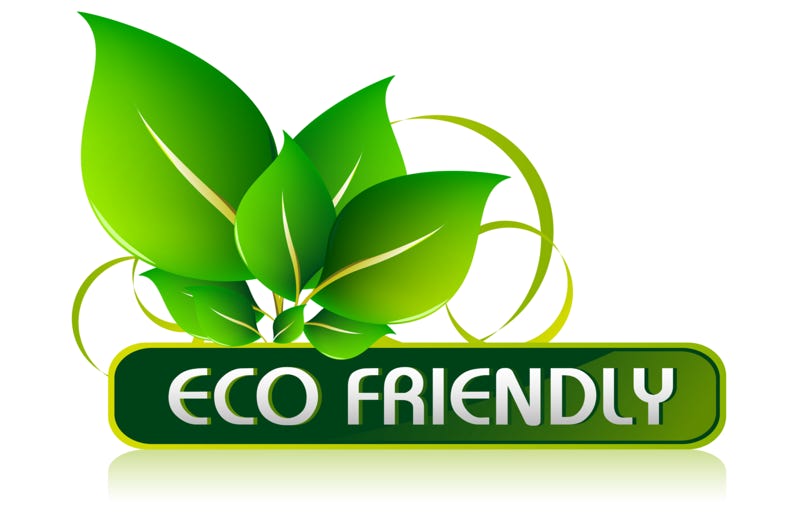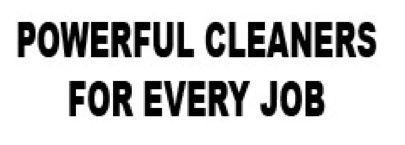




UNIVERSOL ECO is a new generation of pre paint cleaners. After UNIVERSOL came on the market in 1993 as a replacement for ammonia, Chemtec Chemicals / Prochemko comes after 26 years with an even better ecological alternative. Chemtec Chemicals / Prochemko is a producer and supplier of UNIVERSOL and many other professional cleaners. Reducing the use of nuisance and hazardous chemicals in cleaning products has been booming in recent years. UNIVERSOL ECO contains even more raw materials which are not classified and which meet ecological requirements. An important step forward is replacing solvents for even less harmful solvents. For example, UNIVERSOL ECO uses petroleum solvents that are also used in water-based paints and in the cosmetics sector. These raw materials are the future for environmentally responsible cleaning products. Every step forward in reducing harmful chemicals is profit. UNIVERSOL ECO is the ecological replacement for ammonia when it comes to working greener.
There are no harmful or hazardous ingredients in UNIVERSOL ECO.
UNIVERSOL ECO is the most advanced industrial all-purpose cleaner that effortlessly tackles all dirt and grease. UNIVERSOL ECO has strong penetrating ECO components that penetrate into the deepest accumulated fat layers. UNIVERSOL ECO easily breaks down the molecular structure of the most stubborn dirt and grease. UNIVERSOL ECO dissolves the adhesive layers immediately and effectively. Due to its non-flammable, non-toxic and non-corrosive properties, UNIVERSOL ECO can be used everywhere as a particularly safe cleaning agent in all possible forms of serious contamination.
Due to its super concentrated composition UNIVERSOL ECO is particularly economical in use. Depending on the degree of contamination UNIVERSOL ECO should be diluted with water in the ratio 1:100 for cleaning paintwork.
MANUAL DEGREASSING PAINTWORK
THE ADHESION
Because we want the surface to be painted to be free of contamination as much as possible, the surface needs to be cleaned. When using Universol, you clean with very professional degreasers that have been specially developed for the painting industry. Universol does not foam and after cleaning it does not have to be rinsed once again with clean water.
But how do I cleanse in a good way, and what is “washing after” really?
Proper cleaning is the complete release of a surface of pollution. This is very important because we previously learned that the adhesion of paint to pollution can cause detachment. A good cleaning is as follows:
1. Dilute Universol 1: 100 with lukewarm water for light soiling. Examples include nicotine impact, greasy fingers, etc. 1: 100 means that you add 1/10 liter (100ML) of cleaning agent to a three-quarter filled building bucket.
2. Dilute Universol 1:10 with lukewarm water for heavy soiling. Think for example of heavy street pollution, greasy machines, etc. 1:10 means that you add 1 liter (1000ML) cleaning agent to a three-quarter filled building bucket.
3. Do not dilute Universol higher as 1:10 because you always need the water as a means of transport for the removal of the contamination. Moreover, the cleaning capacity will no longer increase with an even heavier dilution.
Use a bucket of clean water next to a bucket of detergent. You need this water to be able to rinse your sponge, brush or cloth during cleaning. What exactly is meant by this? If the surface has been moistened with Universol, the sponge will already absorb a quantity of dirt. Then first wring the sponge out of the pails, then first rinse the wrung out sponge in the clean water and lastly moisten the sponge with the cleaning agent.
Start by cleaning the surface at the top. You apply the detergent and let it take effect. By allowing it to work in, the detergent surface (detergents) of the detergent can release the contamination from the surface. Then the surface must be "set in motion" together with the detergent. In other words, one has to "polish / rub" the surface. As a result, the dirt which has already been loosened by the detergents can be incorporated in the solution and be discharged from the surface. In other words: one must remove "the dirty suds" from the surface. If this was not done and the suds were left to sit, then the dirt adheres to the surface again and no optimum cleaning is achieved.
You can remove the "dirty suds" in the following ways. The soap is taken off with a cloth or a clean sponge is used to remove the surface. In any case, the surface must always be cleaned of the dirty soap and the surface must also be dried. Make sure that no "collection points" can arise where the dirty soap can accumulate. For example, at the bottom in both corners of a frame. Pay extra attention to these types of places. After cleaning, you do not need to wash again. Non-laundering does not mean that you do not have to remove the dirty suds. Non-washing means that you do not have to rinse the surface with clean water after a good cleaning. After all, by completely removing the water the surface will be free of pollution.
For very large surfaces such as sheet piles, silos etc. You can choose to clean as follows. Apply the Universol diluted to the surface. Scrub the
surface. Finally, with clean water high-pressure or low-pressure the soapy water can be removed.
After the cleaning the surface is sanded or sandblasted. Finally, the surface must made dust-free so you can start with the finishing of the surface.
THE CLEANING
Because we want the surface to be painted to be free of contamination as much as possible, the surface needs to be cleaned. When using Universol, you clean with very professional degreasers that have been specially developed for the painting industry. Universol does not foam and after cleaning it does not have to be rinsed once again with clean water.
But how do I cleanse in a good way, and what is “washing after” really?
Proper cleaning is the complete release of a surface of pollution. This is very important because we previously learned that the adhesion of paint to pollution can cause detachment. A good cleaning is as follows:
1. Dilute Universol 1: 100 with lukewarm water for light soiling. Examples include nicotine impact, greasy fingers, etc. 1: 100 means that you add 1/10 liter (100ML) of cleaning agent to a three-quarter filled building bucket.
2. Dilute Universol 1:10 with lukewarm water for heavy soiling. Think for example of heavy street pollution, greasy machines, etc. 1:10 means that you add 1 liter (1000ML) cleaning agent to a three-quarter filled building bucket.
3. Do not dilute Universol higher as 1:10 because you always need the water as a means of transport for the removal of the contamination. Moreover, the cleaning capacity will no longer increase with an even heavier dilution.
Use a bucket of clean water next to a bucket of detergent. You need this water to be able to rinse your sponge, brush or cloth during cleaning. What exactly is meant by this? If the surface has been moistened with Universol, the sponge will already absorb a quantity of dirt. Then first wring the sponge out of the pails, then first rinse the wrung out sponge in the clean water and lastly moisten the sponge with the cleaning agent.
Start by cleaning the surface at the top. You apply the detergent and let it take effect. By allowing it to work in, the detergent surface (detergents) of the detergent can release the contamination from the surface. Then the surface must be "set in motion" together with the detergent. In other words, one has to "polish / rub" the surface. As a result, the dirt which has already been loosened by the detergents can be incorporated in the solution and be discharged from the surface. In other words: one must remove "the dirty suds" from the surface. If this was not done and the suds were left to sit, then the dirt adheres to the surface again and no optimum cleaning is achieved.
You can remove the "dirty suds" in the following ways. The soap is taken off with a cloth or a clean sponge is used to remove the surface. In any case, the surface must always be cleaned of the dirty soap and the surface must also be dried. Make sure that no "collection points" can arise where the dirty soap can accumulate. For example, at the bottom in both corners of a frame. Pay extra attention to these types of places. After cleaning, you do not need to wash again. Non-laundering does not mean that you do not have to remove the dirty suds. Non-washing means that you do not have to rinse the surface with clean water after a good cleaning. After all, by completely removing the water the surface will be free of pollution.
For very large surfaces such as sheet piles, silos etc. You can choose to clean as follows. Apply the Universol diluted to the surface. Scrub the
surface. Finally, with clean water high-pressure or low-pressure the soapy water can be removed.
After the cleaning the surface is sanded or sandblasted. Finally, the surface must made dust-free so you can start with the finishing of the surface.

